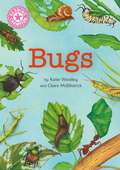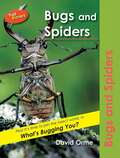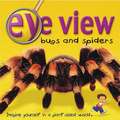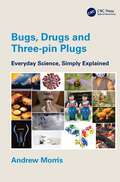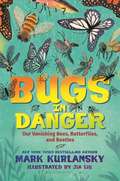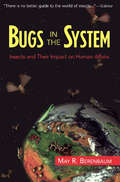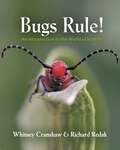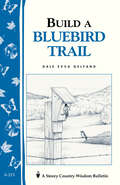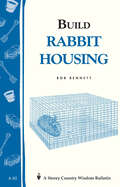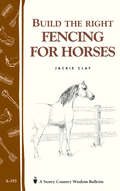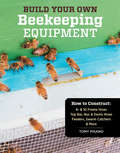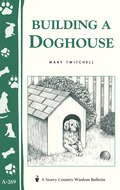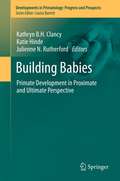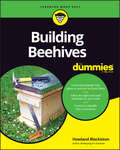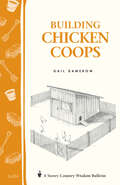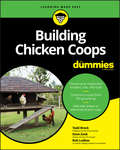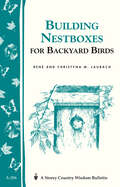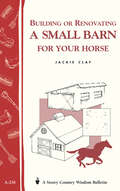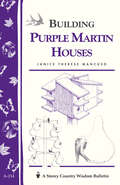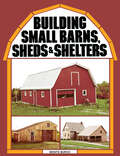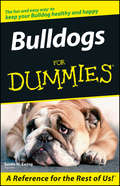- Table View
- List View
Bugs: Independent Reading Non-Fiction Pink 1a (Reading Champion #515)
by Katie WoolleyThis book is part of Reading Champion, a series carefully linked to book bands to encourage independent reading skills, developed with UCL Institute of Education (IOE)Bugs is a non-fiction text exploring how different bugs eat leaves. The repeated sentence structure offers readers the opportunity for a very first independent reading experience with the support of the illustrations.Reading Champion offers independent reading books for children to practise and reinforce their developing reading skills.This non-fiction text is accompanied by engaging artwork and a reading activity. Each book has been carefully graded so that it can be matched to a child's reading ability, encouraging reading for pleasure.
Bugs and Spiders (Trailblazers Ser.)
by David OrmeWhich bug has the most legs? Which bug is the fastest runner? Which spider is the most poisonous? And what's the deadliest bug of all? You might be surprised! This is the world of bugs and spiders. Find out all about it. Get the facts. Got that? Then read 'What's Bugging You?', a story about alien explorers who get a BIG welcome from the local insect life.
Bugs and Spiders: Eye View (PDF)
by Barbara TaylorEach book in this series, aimed at 3-6 year olds, lets them get close to amazing creatures! Short, simple text offers bite-sized chunks of information that is accompanied by close-up photography and magnified images that give an exclusive perspective on subjects. This book focuses on bugs and spiders.
Bugs, Drugs and Three-pin Plugs: Everyday Science, Simply Explained
by Andrew MorrisFor the millions who remain curious about the world around them, but gained little from science at school, this book offers a way forward. Based on live discussions with adults from all walks of life, each chapter begins with an everyday experience, like swallowing a pill or watching a bee on a flower. The main scientific ideas underlying each topic are then explored, so that understanding of a set of fundamental concepts builds up gradually throughout the book. In contrast to more traditional approaches to science learning, topics range freely across the subject areas. The story of Covid, for example includes aspects of biology, chemistry, mathematics and social behaviour. Plain English is used throughout and mathematical expressions are avoided. Key points are illustrated with clear diagrams and photographs. By drawing on questions and perspectives of ordinary people, the book offers an introduction to basic ideas in science as a whole, rather than any one particular subject. For the adult wishing to make good a gap in their understanding it provides a starting point for entering the rich world of popular science.
Bugs, Drugs and Three-pin Plugs: Everyday Science, Simply Explained
by Andrew MorrisFor the millions who remain curious about the world around them, but gained little from science at school, this book offers a way forward. Based on live discussions with adults from all walks of life, each chapter begins with an everyday experience, like swallowing a pill or watching a bee on a flower. The main scientific ideas underlying each topic are then explored, so that understanding of a set of fundamental concepts builds up gradually throughout the book. In contrast to more traditional approaches to science learning, topics range freely across the subject areas. The story of Covid, for example includes aspects of biology, chemistry, mathematics and social behaviour. Plain English is used throughout and mathematical expressions are avoided. Key points are illustrated with clear diagrams and photographs. By drawing on questions and perspectives of ordinary people, the book offers an introduction to basic ideas in science as a whole, rather than any one particular subject. For the adult wishing to make good a gap in their understanding it provides a starting point for entering the rich world of popular science.
Bugs in Danger: Our Vanishing Bees, Butterflies, and Beetles
by Mark KurlanskyBy now you've probably heard that bees are disappearing--but they aren't the only species at risk. Populations of fireflies, butterflies, and ladybugs have all been declining in recent years, too. This middle grade nonfiction explains the growth, spread, and recent declines of each of these four types of insects. Exploring human causes, like the Baltimore electric company that collected fireflies to attempt to harness their phosphorescent lighting source, to natural occurrences, like the mysterious colony collapse disorder that plagues bee populations, master nonfiction storyteller Mark Kurlansky shows just how much bugs matter to our world.
Bugs In The System: Insects And Their Impact On Human Affairs
by May R. BerenbaumAn introduction to insect physiology, genetics and behaviour which looks at the interaction between humans and insects, and explores both the positive and negative aspects of the relationship.
Bugs Rule!: An Introduction to the World of Insects
by Whitney Cranshaw Richard RedakBugs Rule! provides a lively introduction to the biology and natural history of insects and their noninsect cousins, such as spiders, scorpions, and centipedes. This richly illustrated textbook features more than 830 color photos, a concise overview of the basics of entomology, and numerous sidebars that highlight and explain key points. Detailed chapters cover each of the major insect groups, describing their physiology, behaviors, feeding habits, reproduction, human interactions, and more. Ideal for nonscience majors and anyone seeking to learn more about insects and their arthropod relatives, Bugs Rule! offers a one-of-a-kind gateway into the world of these amazing creatures. Places a greater emphasis on natural history than standard textbooks on the subject Covers the biology and natural history of all the insect orders Provides a thorough review of the noninsect arthropods, such as spiders, scorpions, centipedes, millipedes, and crustaceans Features more than 830 color photos Highlights the importance of insects and other arthropods, including their impact on human society An online illustration package is available to professors
Bugs Rule!: An Introduction to the World of Insects
by Whitney Cranshaw Richard RedakBugs Rule! provides a lively introduction to the biology and natural history of insects and their noninsect cousins, such as spiders, scorpions, and centipedes. This richly illustrated textbook features more than 830 color photos, a concise overview of the basics of entomology, and numerous sidebars that highlight and explain key points. Detailed chapters cover each of the major insect groups, describing their physiology, behaviors, feeding habits, reproduction, human interactions, and more. Ideal for nonscience majors and anyone seeking to learn more about insects and their arthropod relatives, Bugs Rule! offers a one-of-a-kind gateway into the world of these amazing creatures. Places a greater emphasis on natural history than standard textbooks on the subject Covers the biology and natural history of all the insect orders Provides a thorough review of the noninsect arthropods, such as spiders, scorpions, centipedes, millipedes, and crustaceans Features more than 830 color photos Highlights the importance of insects and other arthropods, including their impact on human society An online illustration package is available to professors
Build a Bluebird Trail: Storey's Country Wisdom Bulletin A-213 (Storey Country Wisdom Bulletin)
by Dale Evva GelfandConservationists across North America are working to help protect and support bluebirds, and you can do your part by creating a bluebird trail. This is simply a series of nesting boxes (anywhere from a few to a few thousand) set about 300 feet apart along a prescribed route. Dale Gelfand tells you what you need to know about bluebirds and their habits, and she shows you how to create and monitor an effective bluebird trail with well-designed nesting boxes.
Build Rabbit Housing: Storey Country Wisdom Bulletin A-82 (Storey Country Wisdom Bulletin)
by Bob BennettSince 1973, Storey's Country Wisdom Bulletins have offered practical, hands-on instructions designed to help readers master dozens of country living skills quickly and easily. There are now more than 170 titles in this series, and their remarkable popularity reflects the common desire of country and city dwellers alike to cultivate personal independence in everyday life.
Build the Right Fencing for Horses: Storey's Country Wisdom Bulletin A-193 (Storey Country Wisdom Bulletin)
by Jackie ClaySince 1973, Storey's Country Wisdom Bulletins have offered practical, hands-on instructions designed to help readers master dozens of country living skills quickly and easily. There are now more than 170 titles in this series, and their remarkable popularity reflects the common desire of country and city dwellers alike to cultivate personal independence in everyday life.
Build Your Own Beekeeping Equipment: How to Construct 8- & 10-Frame Hives; Top Bar, Nuc & Demo Hives; Feeders, Swarm Catchers & More
by Tony PisanoTony Pisano provides step-by-step illustrated instructions showing you how to build hive bodies, supers, covers, stands, frames, swarm catchers, feeders, and more using basic hand tools and easy-to-find materials.
Building a Doghouse: (Storey's Country Wisdom Bulletins A-269) (Storey Country Wisdom Bulletin)
by Mary TwitchellBuild a Doghouse That's Just Right for Your Dog!While your dog may be a full-fledged member of the family, there are times when you must put him or her outdoors. Some dogs, for example, become over enthusiastically friendly when visitors appear, even to the point of knocking down your unsuspecting guests. Other dogs enjoy having some time to themselves in the backyard. Whatever the reason that shepherds the dog out the door, a nearby doghouse within a fenced-in area provides a protected, private space for your dog and peace of mind for you. A proper doghouse is a canine retreat, a place where your dog can hide from the hot sun, the cold rain, the harsh wind, and the worries of the world. Mary Twitchell takes you through all the options for building or buying a comfortable and cozy shelter for your canine companion. Whether you want to modify a barrel, buy a molded plastic shelter, or build a wooden doghouse, you'll find all the information you need right here, from choosing the right site to proper building techniques to encouraging your dog to use the new doghouse.
Building Babies: Primate Development in Proximate and Ultimate Perspective (Developments in Primatology: Progress and Prospects #37)
by Kathryn B.H. Clancy, Katie Hinde and Julienne N. RutherfordThe ontogeny of each individual contributes to the physical, physiological, cognitive, neurobiological, and behavioral capacity to manage the complex social relationships and diverse foraging tasks that characterize the primate order. For these reasons Building Babies explores the dynamic multigenerational processes of primate development. The book is organized thematically along the developmental trajectory:conception, pregnancy, lactation, the mother-infant dyad, broader social relationships, and transitions to independence. In this volume, the authors showcase the myriad approaches to understanding primate developmental trajectories from both proximate and ultimate perspectives. These collected chapters provide insights from experimental manipulations in captive settings to long-term observations of wild-living populations and consider levels of analysis from molecule to organism to social group to taxon. Strepsirrhines, New World monkeys, Old World monkeys, apes, and humans are all well-represented. Contributions by anthropologists, microbiologists, psychologists, population geneticists, and other primate experts provide Building Babies a uniquely diverse voice. Building Babies features multi- and trans-disciplinary research approaches to primate developmental trajectories and is particularly useful for researchers and instructors in anthropology, animal behavior, psychology, and evolutionary biology. This book also serves as a supplement to upper-level undergraduate courses or graduate seminars on primate life history and development. In these contexts, the book provides exposure to a wide range of methodological and theoretical perspectives on developmental trajectories and models how researchers might productively integrate such approaches into their own work.
Building Beehives For Dummies
by Howland BlackistonBuilding Beehives For Dummies (9781119544388) was previously published as Building Beehives For Dummies (9781118312940). While this version features a new Dummies cover and design, the content is the same as the prior release and should not be considered a new or updated product. The easy way to build your own beehives and beekeeping equipment Building Beehives For Dummies is the follow-up book to the bestselling Beekeeping For Dummies. It provides everything you need to learn how to build some of the world's most popular hives and beekeeping accessories. For each design the book includes a detailed materials list (what lumber, hardware and fasteners you'll need), step-by-step building instructions, and illustrative drawings that show how the components all fit together. There are over a dozen plans in all, including the traditional Langstroth hive, the eight frame garden hive, designs for elevated hive stands, the Warre hive, screened bottom board, the Kenya top-bar hive, four-frame observation hive, hive top feeders, and more. The book contains introductory chapters that teach you the basic carpentry skills necessary to build any of the plans in the book. Whether you are a new beekeeper or a seasoned ol’timer, Building Beehives for Dummies provides you with the information you need to plan and succeed at building beehives (and other cool accessories). You'll discover what type of hive to build, hints on how to maintain your equipment, what bees need to stay happy and healthy, where to locate your hive, and much more. Covers "bee space," the critical technical measurement within a beehive that's crucial for easy inspection of your colonies Offers guidance on keeping both urban and suburban neighbors happy, getting proper permissions, and understanding regional laws and regulations Provides creative ideas for dressing up hives for fun and profit In today’s world of self-sufficiency, back-to-basics and sustainability, building beehives is a fun hobby that both you and your bees will appreciate and benefit from.
Building Beehives For Dummies
by Howland BlackistonBuilding Beehives For Dummies (9781119544388) was previously published as Building Beehives For Dummies (9781118312940). While this version features a new Dummies cover and design, the content is the same as the prior release and should not be considered a new or updated product. The easy way to build your own beehives and beekeeping equipment Building Beehives For Dummies is the follow-up book to the bestselling Beekeeping For Dummies. It provides everything you need to learn how to build some of the world's most popular hives and beekeeping accessories. For each design the book includes a detailed materials list (what lumber, hardware and fasteners you'll need), step-by-step building instructions, and illustrative drawings that show how the components all fit together. There are over a dozen plans in all, including the traditional Langstroth hive, the eight frame garden hive, designs for elevated hive stands, the Warre hive, screened bottom board, the Kenya top-bar hive, four-frame observation hive, hive top feeders, and more. The book contains introductory chapters that teach you the basic carpentry skills necessary to build any of the plans in the book. Whether you are a new beekeeper or a seasoned ol’timer, Building Beehives for Dummies provides you with the information you need to plan and succeed at building beehives (and other cool accessories). You'll discover what type of hive to build, hints on how to maintain your equipment, what bees need to stay happy and healthy, where to locate your hive, and much more. Covers "bee space," the critical technical measurement within a beehive that's crucial for easy inspection of your colonies Offers guidance on keeping both urban and suburban neighbors happy, getting proper permissions, and understanding regional laws and regulations Provides creative ideas for dressing up hives for fun and profit In today’s world of self-sufficiency, back-to-basics and sustainability, building beehives is a fun hobby that both you and your bees will appreciate and benefit from.
Building Chicken Coops: Storey Country Wisdom Bulletin A-224 (Storey Country Wisdom Bulletin)
by Gail DamerowSince 1973, Storey's Country Wisdom Bulletins have offered practical, hands-on instructions designed to help readers master dozens of country living skills quickly and easily. There are now more than 170 titles in this series, and their remarkable popularity reflects the common desire of country and city dwellers alike to cultivate personal independence in everyday life.
Building Chicken Coops For Dummies
by Todd Brock David Zook Rob LudlowBuilding Chicken Coops For Dummies (9781119543923) was previously published as Building Chicken Coops For Dummies (9780470598962). While this version features a new Dummies cover and design, the content is the same as the prior release and should not be considered a new or updated product. As the popularity of urban homesteading and sustainable living increases, it’s no wonder you’re in need of trusted, practical guidance on how to properly house the chickens you’re planning (or have already begun) to keep. Building Chicken Coops For Dummies gives you the information you need to build the most cost-efficient, safe, and easy-on-the-eye enclosures for your backyard flock. This practical guide gives you easy-to-follow and customizable plans for building the backyard chicken coop that works best for you. You’ll get the basic construction know-how and key information you need to design and build a coop tailored to your flock, whether you live in a small city loft, a suburban backyard, or a small rural farm. Includes detailed material lists, instructions, and schematic plans for building a host of different chicken coops Step-by-step guidance on how to build a coop—or design your own Accessible for every level of reader Whether you’re just beginning to gain an interest in a back-to-basics lifestyle or looking to add more attractive and efficient coops to your current flock‘s digs, Building Chicken Coops For Dummies gives you everything you need to build a winning coop!
Building Chicken Coops For Dummies
by Todd Brock David Zook Rob LudlowBuilding Chicken Coops For Dummies (9781119543923) was previously published as Building Chicken Coops For Dummies (9780470598962). While this version features a new Dummies cover and design, the content is the same as the prior release and should not be considered a new or updated product. As the popularity of urban homesteading and sustainable living increases, it’s no wonder you’re in need of trusted, practical guidance on how to properly house the chickens you’re planning (or have already begun) to keep. Building Chicken Coops For Dummies gives you the information you need to build the most cost-efficient, safe, and easy-on-the-eye enclosures for your backyard flock. This practical guide gives you easy-to-follow and customizable plans for building the backyard chicken coop that works best for you. You’ll get the basic construction know-how and key information you need to design and build a coop tailored to your flock, whether you live in a small city loft, a suburban backyard, or a small rural farm. Includes detailed material lists, instructions, and schematic plans for building a host of different chicken coops Step-by-step guidance on how to build a coop—or design your own Accessible for every level of reader Whether you’re just beginning to gain an interest in a back-to-basics lifestyle or looking to add more attractive and efficient coops to your current flock‘s digs, Building Chicken Coops For Dummies gives you everything you need to build a winning coop!
Building Nest Boxes for Backyard Birds: Storey's Country Wisdom Bulletin A-206 (Storey Country Wisdom Bulletin)
by Christyna M. Laubach René LaubachThis concise guide offers easy-to-follow, step-by-step instructions for building eight different nestboxes. Each nestbox is designed to attract and house different kinds of backyard birds, including bluebirds, swallows, wrens, chickadees, nuthatches, Red-Bellied Woodpeckers, Northern Flickers, Wood Ducks, Hooded Mergansers, American Kestrals, Screech Owls, Northern Saw-Whet Owls, and Great Crested or Ash-Throated Flycatchers.
Building or Renovating a Small Barn for Your Horse: Storey Country Wisdom Bulletin A-238 (Storey Country Wisdom Bulletin)
by Jackie ClaySince 1973, Storey's Country Wisdom Bulletins have offered practical, hands-on instructions designed to help readers master dozens of country living skills quickly and easily. There are now more than 170 titles in this series, and their remarkable popularity reflects the common desire of country and city dwellers alike to cultivate personal independence in everyday life.
Building Purple Martin Houses: Storey's Country Wisdom Bulletin A-214 (Storey Country Wisdom Bulletin)
by Janice Therese MancusoAttract and maintain a purple martin colony! Janice Mancuso shows you exactly how to do it. From finding the right site and choosing the best housing materials to constructing a martin house with suitable entrance holes and predator guards, you’ll find everything you need to know in this concise guide.
Building Small Barns, Sheds & Shelters
by Monte BurchBuild your own outbuildings and enjoy the space to do more of what you love. From simple toolsheds and animal shelters to smokehouses and low-cost barns, Monte Burch guides you through everything you need to know to make your small building projects a reality. Detailed blueprints, easy-to-follow instructions, and expert advice are suited to even the first-time builder. Discover how easy it is to create your own customized spaces that will allow your passions to grow.
Bulldogs For Dummies
by Susan M. EwingFind out how to select, train, and care for your Bulldog Though originally bred for bull baiting, today's Bulldogs are calm, dignified, and courageous - and make great pets. Whether you're already a Bulldog owner or you're thinking about becoming one, this friendly guide will answer your questions and help you and your Bully live happily ever after. From choosing your dog to training, diet, and health, it's just what you need for Bulldog success! Discover how to * Understand the breed and its history * Buy or adopt a healthy Bulldog * Housetrain your Bulldog and teach basic commands * Keep your Bulldog well-groomed and active * Watch for breed-specific health problems
